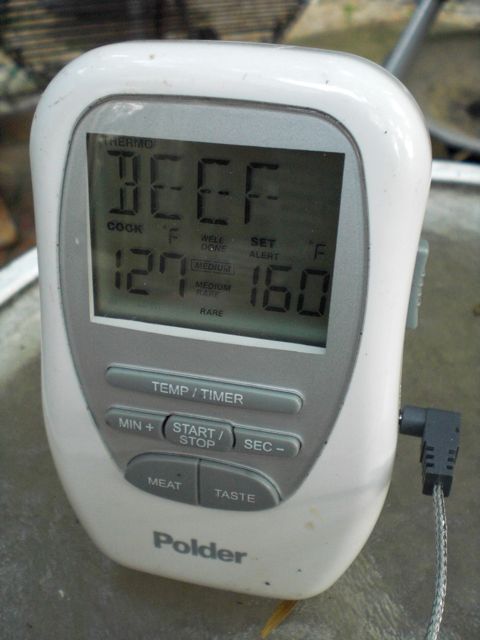This is definitely not an Izakaya item but I have to "pad" my blog sometimes. Since it was Memorial day and the official beginning of the summer, it is customary to do barbecue in the U.S. I often barbecue whole chickens in
a Weber kettle. Once you set it up, you can just relax for 90 minutes or so while enjoying the sublime aroma of the chicken cooking. The result is quite good especially the crispy skin.
While the chicken is resting, portions of crispy skin get eaten by somebody. I caught the crime scene.

1.
Preparing the chicken: I first make a mixture of freshly cracked black pepper and Kosher salt (half and half, about 3-4 tbs for two birds). After washing the birds well and drying with paper towels, I remove the wish bones (or "clavicle" if you get technical) using a small paring knife. It will make a big difference later when you are carving the breast meat. I first squeeze lemon wedges (2 per bird) inside the cavity and outside. I then liberally sprinkle the pepper/salt mixture inside the cavity and stuff the cavity with aromatic vegetables, including the lemon wedges used for the juice, just for added flavor. I use coarsely chopped onion and celery (especially the core portion with leaves) and garlic cloves (5-6 crushed cloves per bird) and sprigs of fresh rosemary (slightly bruised to release the nice essential oil). I truss the birds without using a trussing needle. I start by wrapping butcher's twine around the "Pope's nose" in the mid portion of the string, then make a figure 8 around both legs, and go across to the back and tie it securely at the back just above the wings and then put the wings akimbo. Then, I smear olive oil all over the skin and generously coat the surface with the black pepper/salt mixture.
2.
Setting up Weber Kettle Grill: We need to use the indirect heat set up. For this, we set up two charcoal baskets which sit on both sides of the inside of the Weber. We use lump charcoal and start it in a chimney-style charcoal starter with crumpled news papers (WSJ seems to work best for some reason) in the bottom. Recently we started using the hollow cardboard core from paper towel rolls and pack the coal around the roll to create a smoke stack. This makes the charcoal ready more quickly and reliably with less smoke. After the charcoal is ready (about 10 minutes), pour the hot charcoal into the baskets. Place a disposable aluminum tray in the middle to catch the drippings. Place the metal grate (which can be opened on both sides over the charcoal baskets to allow the addition of wood chips).
3. Wood chips: I use hot smoking for added flavors. I soak Apple wood chips (two fistfuls) for, at least, 30 minutes. After placing the chickens (this Weber can take two full size chickens) in the middle on the grate over the drip pan, I open both sides of the grate and place the drained and moist wood chips over the charcoal and place the lid with the air vents fully open. You immediately smell nice sweet apple wood smoke.

3.
Judging the doneness: Depending on the wind, ambient temperature (We are known to barbecue in winter. In that case, it will take little longer), and the size of the birds, it will take between 1 hours 15 minutes to 1 and a half hour. I do not have to add any coals during the cooking. After 1 hour and 10 minutes, I insert a temperature probe of a remote meat thermometer with an alarm (it has a beeper you can wear on your belt and it shows the internal temperature and beeps when the set temperature is reached. Shown here is the base unit.) The probe has to be inserted into the deepest part of thigh but not touching the bone. Please note that I had set the alarm at "Beef, Medium" which is 160F. If you choose "Chicken" it will set to 175F. I want 165F, so I let it cook 5 more minutes after 160F is reached and let the birds rest for 15-30 minutes, the truss removed but uncovered. This will produce a perfect doneness without over cooking. The reason I do not insert the probe (which is supposedly to be used in a grill) from the beginning is that I had quite a few probes go bad on me when used this way. So I reduce the time the probe and the wire stay in the grill and also make sure the wire goes through the center area of the grill without hot charcoals underneath.
The skin is without a doubt the best part. My wife likes the wings and I like the dark meat of the thigh. We do not need any gravy or sauce for this. We had the chicken with a trio of home made salads; potato, macaroni and corn with black beans.
A nice start of the summer.
